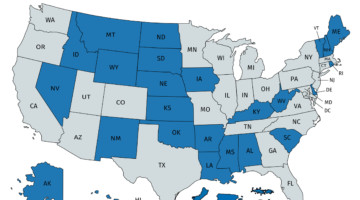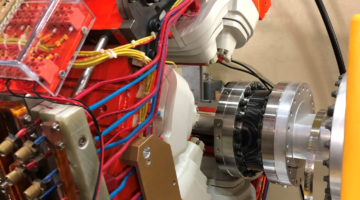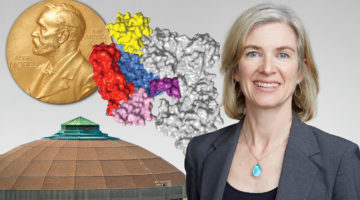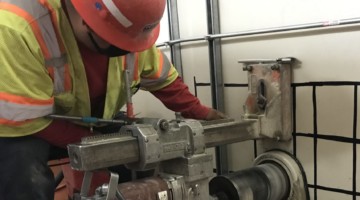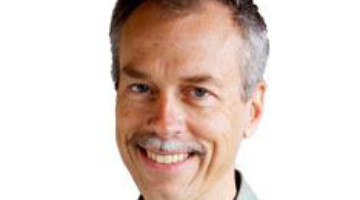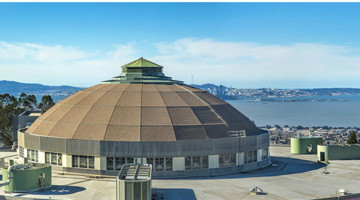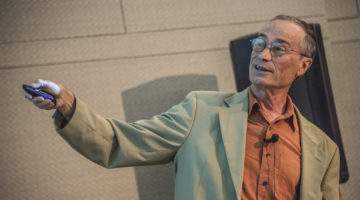The DOE Established Program to Stimulate Competitive Research (DOE EPSCoR) encourages partnerships between national labs and researchers in qualifying states and territories. An EPSCoR collaboration with researchers from Kentucky has resulted in an ALS highlight, career advancement for young scientists, and a larger, center-scale proposal. Read more »
Features
Winter 2021 Shutdown Recap
During the Winter 2021 shutdown, the ALS was a hive of activity, though social distancing requirements during the pandemic meant that the activity looked a bit different from years past. We began commissioning on March 26 and plan to return to user operations after commissioning concludes. Read more »
Demolition Day: Building 7, Last Bastion of “Old Town,” Makes Way for the Future
On Saturday morning, November 28, 2020, a demolition crew made quick work of de-constructing Building 7, a 75-year-old two-story wooden structure adjacent to the Advanced Light Source (ALS) and the last holdout from a cluster of buildings in the area known as “Old Town.” Read more »
Jennifer Doudna and the Nobel Prize: The Advanced Light Source Perspective
The 2020 Nobel Prize in Chemistry was awarded to Jennifer Doudna and Emmanuelle Charpentier for the development of a world-changing gene-editing technology. At the ALS, Doudna’s work on CRISPR-Cas9 was enabled by many visionary people with innovative ideas, implemented in support of a world-class structural biology program. Read more »![]()
Summer 2020 Shutdown Recap
With all the changes due to COVID-19, it is no surprise that this summer’s ALS shutdown was also affected. It began later (August instead of July) and was shorter than originally scheduled (about six weeks instead of three months). Nevertheless a number of smaller activities, many in preparation for the ALS Upgrade (ALS-U), were accomplished. Read more »
Eric Gullikson Receives 2020 Klaus Halbach Award
When Eric Gullikson first arrived at Berkeley Lab, the Advanced Light Source (ALS) did not yet exist. Thanks to his work, not only has the ALS grown in scale, capability, and renown, but other light sources worldwide have benefited as well. The ALS Users’ Executive Committee recognized Gullikson, staff scientist, for “contributions to x-ray metrology that are central to building beamlines at the ALS and around the world.” Read more »
Tom Scarvie Receives 2020 Renner User Services Award
At this year’s ALS User Meeting, Tom Scarvie, head of the ALS Operations Group, was honored with the 2020 Renner Award. The ALS Users’ Executive Committee selected Scarvie “for coordinating all accelerator and beamline floor operator activities to provide reliable light to users safely.” Read more »
2020 ALS User Meeting Highlights
An experiment born of necessity, the 2020 ALS User Meeting was held August 25–28, “in silico.” The results have been generally positive, revealing emergent benefits to interactions occurring in the virtual realm, even as we hope for a return to real space ASAP. Read more »
2020 Shirley Award to Honor Miquel Salmeron
By taking surface studies from ultrahigh vacuum to near-ambient pressure, Miquel Salmeron’s work at the ALS has had deep impact on a broad range of scientific questions, revealing the chemical, electronic, and mechanical properties of surfaces and interfaces on the nanometer (and often atomic) scale. Read more »
Masks On, Ready to Work: Meet the People Supporting COVID-19 Science
David Richardson’s job is literally to make sure the light stays on. But it’s not just any light—it’s a very special x-ray light that could play a crucial role in an eventual treatment for COVID-19. Richardson is an operator at the ALS, and is one of a handful of workers providing essential services to scientists working on COVID-19-related research. Read more »
- « Previous Page
- 1
- …
- 5
- 6
- 7
- 8
- 9
- …
- 14
- Next Page »
